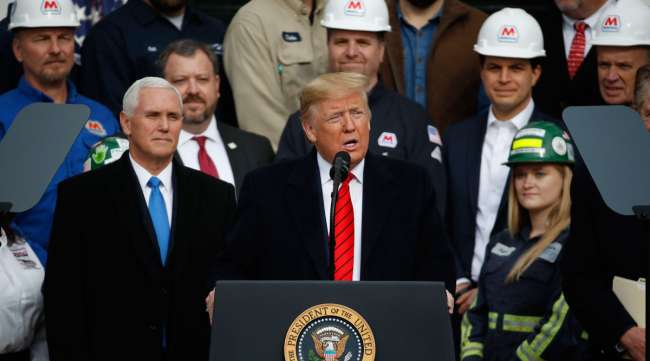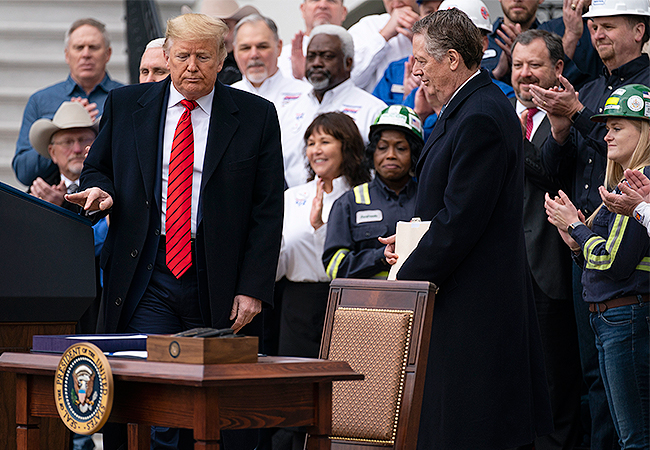Associated Press
Trump Signs USMCA Agreement Into Law

[Stay on top of transportation news: Get TTNews in your inbox.]
WASHINGTON — President Donald Trump on Jan. 29 signed into law a major rewrite of the rules of trade with Canada and Mexico that he said replaces the “nightmare” of a Clinton-era agreement and will keep jobs, wealth and growth in America.
Trump made renegotiating the North American Free Trade Agreement a priority during his 2016 campaign, although trade experts say the impact of the new U.S.-Mexico-Canada Agreement will be modest.
“This is a cutting-edge, state-of-the-art agreement that protects, defends, and serves the great people of our country,” Trump said in an outdoor signing ceremony at the White House, where the invitation list included more than 70 Republican members of Congress but no Democratic legislators. “Together we are building a glorious future that is raised, grown, built and made right here in the glorious U.S.A.”
In part one of a two-part exploration of autonomous technology today, our latest RoadSigns podcast revisits conversations with CEOs Alex Rodrigues of Embark and Cetin Mericli of Locomation. Hear them explain what testing automated trucks and developing platooning technology has taught them about the road ahead — and get new perspective with host commentary. Listen to a snippet from Rodrigues above, and to hear the full episode, go to RoadSigns.TTNews.com.
Canada and Mexico already represent the top two export markets for U.S. goods. But the new pact, along with the signing of a phase one agreement with China, dials down trade tensions that contributed to slowing economic growth globally.
The leaders of the U.S., Canada and Mexico signed the deal in late 2018. Legislation implementing it received overwhelming, bipartisan support in Congress after several months of behind-the-scenes negotiations between Democratic lawmakers and the Trump administration.
Trump made a point of praising Republican legislators for their work in passing the deal but did not mention the role of Democrats, who said that even if they weren’t invited to the signing ceremony, their influence was being felt.
“What the president will be signing is quite different from what the president sent us,” said House Speaker Nancy Pelosi (D-Calif). “We were able to make vast improvements. If we weren’t, we would not have been able to pass the bill.”
Rep. Richard Neal, chairman of the House Ways and Means Committee, said it only passed Congress because of how the Democrats forced changes in Trump’s original proposal. “They voted for it for one reason, is because of how we shaped and altered the president’s proposal,” said Neal (D-Mass.).
Proud to be represented at @WhiteHouse this morning for #USMCA signing. This trade agreement paves the way to a stronger economy, stronger trucking industry and more jobs. #USMCAnow pic.twitter.com/WACNTxnP6r — American Trucking (@TRUCKINGdotORG) January 29, 2020
“Today’s signing ceremony is the beginning of the next phase in our strong and productive relationship with Mexico and Canada,” said ATA President Chris Spear. “ATA and our members are proud to have been engaged throughout the process, attending the ministerial conferences and working with the administration and our trucking partners in Canada and Mexico to shape this final outcome. We commend President Trump for making this a top priority of his presidency and seeing it through to completion.”
NAFTA, which took effect in 1994 under President Bill Clinton, tore down trade barriers among the three North American countries and commerce among them surged. But Trump and other critics said NAFTA encouraged factories to leave the United States and relocate south of the border to take advantage of low-wage Mexican labor.
Trump threatened to leave NAFTA if he couldn’t get a better deal, creating uncertainty over regional trade.
His trade negotiator, Robert Lighthizer, pressed for a revamped pact designed to bring factory jobs back to the United States. The new agreement, for example, requires automakers to get 75% of their production content (up from 62.5% in NAFTA) from within North America to qualify for the pact’s duty-free benefits. That means more auto content would have to come from North America, not imported more cheaply from China and elsewhere.
At least 40% of vehicles also would have to originate in places where workers earn at least $16 an hour. That would benefit the United States and Canada — not Mexico, where auto assembly workers are paid a fraction of that amount.

Members of America's Road Team, in white shirts, attend a ceremony with President Trump and Trade Representative Robert Lighthizer (right) at the White House Jan. 29 in which Trump signed the United States-Mexico-Canada Agreement into law. (Evan Vucci/AP)
The independent U.S. International Trade Commission last year calculated that the U.S.-Mexico-Canada deal would add 0.35%, or $68 billion, to economic growth and generate 176,000 jobs over six years — not much of a change for a $22 trillion economy with 152 million nonfarm jobs.
“It’s a blip,” said Syracuse University economist Mary Lovely, who studies trade. “The main thing is what it isn’t: It isn’t a continuation of uncertainty, and it isn’t a major disruption” to business.
Critics include environmental groups concerned that the agreement does not address global warming. Some conservatives say the agreement will make cars and other products more expensive for consumers.
The president is ready to highlight the deal in battleground states that will determine who wins this year’s election. He will travel Jan. 30 to Michigan, where some of the state’s auto workers should benefit from a deal that encourages more manufacturing in the United States.
Trump wants to talk up a deal that about 4 in 5 Americans have heard little or nothing about. Indeed, while a third of the public approves of the deal and only 5% disapprove, a solid majority, 61%, have not formed an opinion, according to a recent poll conducted by Monmouth University.
Want more news? Listen to today's daily briefing:


